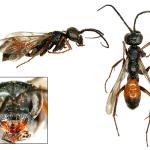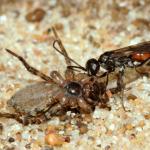A medium-sized, black and red species. In the female the clear window in the otherwise infuscate wing-tip, usually characteristic of its subgenus, is absent or poorly developed. The male subgenital plate is fairly distinctive, but must be extruded fully.
Throughout mainland Britain, although mainly coastal in the west, and most frequent in the south-east. Not recorded from Ireland (O’Connor et al., 2009), but known from the Channel Islands.
Overseas it occurs in western Europe and Fennoscandia, although absent from the Iberian peninsula and other parts of the extreme south (Wahis, 2011). Also found in central Asia and North Africa (Wolf, 1972).
This species is not regarded as being scarce or threatened.
It is predominantly a species of sandy soils; heathland, acid grassland and coastal sites.
From May to September, but more frequent in late summer.
Prey consists mainly of spiders in the family Lycosidae, also Thomisidae and Salticidae.
No data available. Related species excavate nests in soil, often taking advantage of natural cavities and abandoned aculeate burrows.
It has been recorded visiting wild carrot (Baldock, 2010; pers. obs.).
2016



